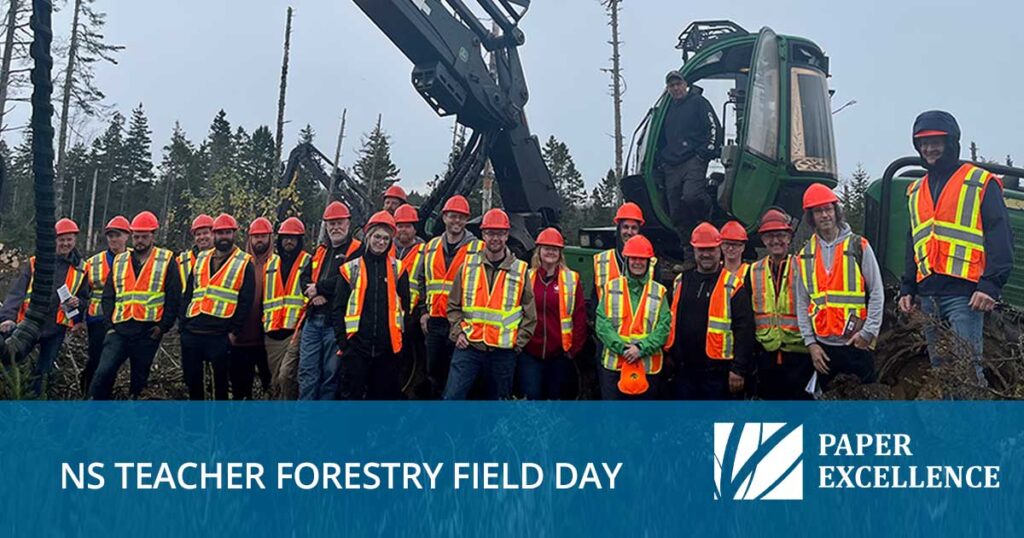
Kendall Spencer, who provides communications support to Paper Excellence Canada, joined Paper Excellence, the Careers and Technology Education Association of Nova Scotia, and other Nova Scotia forestry players on the recent Forestry Field Day for Teachers. This was a professional development opportunity for Kendall to expand her knowledge of the distinctive dynamics of the forestry sector in Nova Scotia.
A few weeks back, I travelled through the forestry hubs of Colchester County with teachers from across Nova Scotia to broaden my understanding of the province’s forestry sector. The trip included a holistic look into the sector, from planning to harvesting to product manufacturing, and sent us home with valuable knowledge and takeaways.
Understanding Ecological Forestry
Our day began in Riversdale, Nova Scotia, where Rick Archibald and Karl Whiffen of Paper Excellence, as well as Forest Nova Scotia and Canadian Woodlands Forum representatives, explained the 160-year history of Riversdale’s forestry management.
The heart of our discussions centred around the newly adopted ecological forestry approach to forest management of Crown land in Nova Scotia, as introduced in the Lahey Report (2018). This triad approach, often referred to as ecological forestry, divides Crown land into three distinct zones – conservation zones, high-production forest zones, and ecological zones.
What stood out to me was Paper Excellence’s adoption of this approach extending not only to Crown lands under their management but also to their privately owned lands. A conscious decision to allocate portions of their land to conservation and ecological forestry demonstrated their commitment to aligning with the province’s ecological vision.
Mitigating the Impacts of Natural Disasters
The next part of our field trip involved witnessing a live salvage operation and discussing a biodiversity research trial in Riversdale. At the site, Rick, Karl, representatives from the Nova Scotia Department of Natural Resources and Renewables, and Forestry Equipment owners (and operators) from Shay and Phillips Forestry Ltd. explained the impacts of wind events, such as Post-Tropical Storm Fiona, on harvesting operations and how we need to proactively prepare for them. At this site, we discovered the importance of salvage operations in forest fire prevention, especially given the historic wildfire season in Nova Scotia last summer.
Before a live demonstration of the salvage operation, teachers had an opportunity to familiarize themselves with the cutting-edge harvester used by Shay and Phillips Ltd. The harvester gave our group a valuable look into the industry’s constant evolution and major technological advances.
The tour hosts also highlighted the impressive skills of Forestry Equipment Operators. To run an efficient operation, these Operators require tree identification capabilities, a deep understanding of the tree use (e.g., studs, sawlogs, pulp), and excellent driving abilities. Due to the job’s demands, the Forestry Sector Council is advocating for the recognition of Forestry Equipment Operators (Harvester and Forwarder) under Nova Scotia’s Apprenticeship and Trades Qualifications Act.
The Final Product
Our last destination on the tour was J.D. Irving’s Sproule Sawmill in Valley, Nova Scotia. We had a chance to explore the intricacies of wood product manufacturing and the efficiencies of today’s lumber production process.
The comprehensive use of wood products really caught my interest. Each part of the log is used, including the products (chips, sawdust, shavings, and bark) that didn’t make the cut for lumber production. To my surprise, these products represent approximately 50% of the log. The sawdust, bark, and shavings find new purpose in heating the mill’s dry kilns for lumber drying. Additionally, they are sold to the nearby Dalhousie Agricultural campus co-generation plant to generate electricity. The waste heat produced during electricity generation is then utilized to heat the campus. The total use of the wood products underscored a strong commitment to sustainability—a recurring theme observed throughout the day.
The trip was an excellent showcase of the unique and innovative landscape of Nova Scotia’s forestry sector. It was an enlightening experience for me and an excellent opportunity for the educators of the Careers and Technology Education Association of Nova Scotia.
